 Bomber Command
Bomber Command  |
Aircrew Chronicles
|
Aircrew Losses
|
Nose Art
|
BCATP
|
Lancaster
|
Media
|
Aircrew Chronicles
|
Aircrew Losses
|
Nose Art
|
BCATP
|
Lancaster
|
Media
 Bomber Command
Bomber Command  |
Aircrew Chronicles
|
Aircrew Losses
|
Nose Art
|
BCATP
|
Lancaster
|
Media
|
Aircrew Chronicles
|
Aircrew Losses
|
Nose Art
|
BCATP
|
Lancaster
|
Media
Commissioned in 1941, the German Navy's mighty 42,900 ton Tirpitz posed a grave threat to Allied shipping. Sister ship to the more famous Bismarck, the battleship carried a main armament of eight 15 inch guns. She saw limited action, spending her war career in Norwegian waters where she was a constant danger to Allied convoys bound for Russia. Her presence obliged the Allies to maintain a large fleet in northern waters to guard against her and repeated attempts were made by both the Royal Air Force and Royal Navy to sink her. |
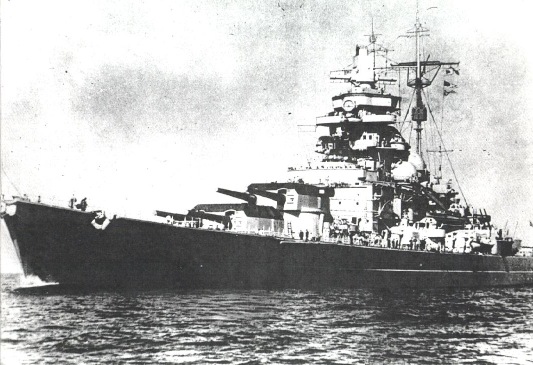
|
|
 |

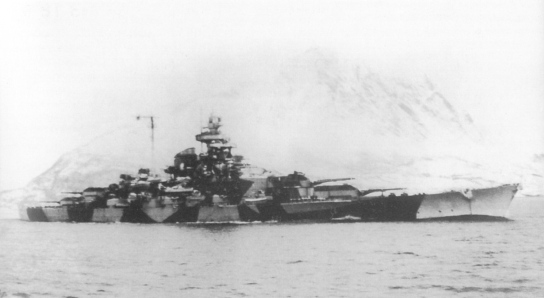 |
The Tirpitz was first bombed by the Royal Air Force in January of 1941 while it was being completed in a Wilhelmshaven dry dock. Crews reported that bombs had "straddled" the battleship. Other attacks were made later in 1941 by twin engined bombers and in April, 1942 the Tirpitz was located and attacked by Halifaxes and Lancasters but no bombs found their target. The Royal Navy attacked the battleship on a number of occasions with miniature submarines and carrier based aircraft. |
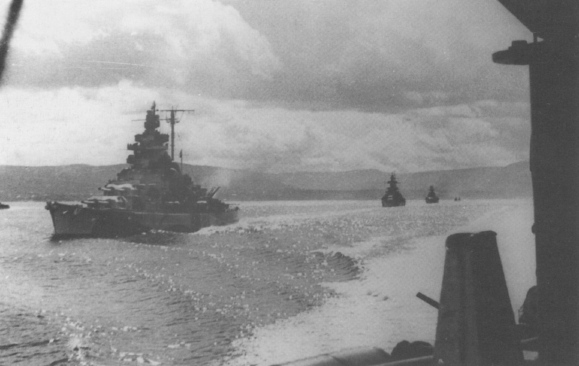 German units having assembled in Altafjord preparatory to an offensive against the Allied Murmansk convoys, one of the two battlegroups sets out, with Tirpitz leading the heavy cruisers Admiral Hipper and Admiral Scheer. |
These attacks were somewhat successful but little effect on the battleship's double layer of armour plate could be expected until British inventor, Sir Barnes Wallis, built a special bomb for the job. Wallis had previously developed the bouncing bomb used in the Dambusters Raid. In 1944 he devised the "Tallboy", a 12,030 pound weapon capable of piercing the Tirpitz's armour plating. |
 |
On September 11, 1944, 38 Lancasters of 9 and 617 Squadrons set out to fly to an airfield in Northern Russia which was to be used as a base for an attack on the battleship which was at anchor in Kaa Fjord in Northern Norway. Several of the bombers were forced to crash-land and only 27 took off on September 15th, 20 carrying Tallboys.
With mountains screening the Lancasters' approach from enemy radar, the Tirpitz was caught by surprise and her smoke-screens were late in starting. One Tallboy smashed through the Tirpitz's forecastle and burst deep in her hull. The shock caused by the explosion of this bomb or possibly other bombs which were near misses, also damaged the ship's engines. All of the Lancasters returned safely to the airfield in Russia. The Germans decided that it was not practical to make Tirpitz fully seaworthy again and she was moved to Tromso, further south in Norway, but only for use as a semi-static, heavy artillery battery.
The British were not aware of the extent of the damage and the Tirpitz was attacked again on October 29th. 37 Lancasters were dispatched from Lossiemouth, Scotland. With the removal of the Lancaster's mid-upper gun turrets and the installation of extra fuel tanks, the Tirpitz could now be reached directly from Britain, although it required a 2250 mile operation.
The weather was ideal for the attack until an unexpected wind shift covered the Tirpitz with cloud just thirty seconds before the first Lancaster was ready to bomb. 32 aircraft released Tallboys on the estimated position but no direct hits were scored. The Germans responded by basing a fighter wing at a nearby airfield.
The final attack took place on November 12, 1944. Thirty Lancasters from No. 9 Squadron led by S/L A.G. Williams DFC and No. 617 Squadron led by Wing Commander J.B. "Willie" Tait DSO DFC took off from Scotland. The weather was clear as the bombers flew at 1,000 feet to avoid early detection by enemy radar prior to rendezvousing at a lake 100 miles southeast of Tromso. The attacking force then climbed to bombing height - between 12,000 and 16,000 feet - and the warship was sighted from about 20 miles away.
For some reason, despite frantic calls for air cover to the German fighter base at Bardufoss, not a single fighter seems to have taken off. There was no smokescreen as the Lancasters passed over the last mountain and the fjord with the Tirpitz came into view. When the bombers were about 13 miles away, the anti-aircraft guns of the Tirpitz opened fire and were then joined by shore batteries and two flak ships. The bombs were released and the crews waited thirty long seconds for the results. The first bombs narrowly missed the target, but then a great yellow flash burst on the foredeck and the Tirpitz was seen to tremble as it was hit by at least two Tallboys. A column of steam and smoke shot up to about 300 feet and within a few minutes the ship had started to list badly. It then suffered a tremendous explosion as the ammunition stores magazine went up. She rolled over to port and capsized. About 10 minutes after the first bomb struck, the Tirpitz had completely turned turtle with only the hull visible from the air. Approximately 1000 of her crew were killed. None of the attacking aircraft were significantly damaged and all returned safely to base.
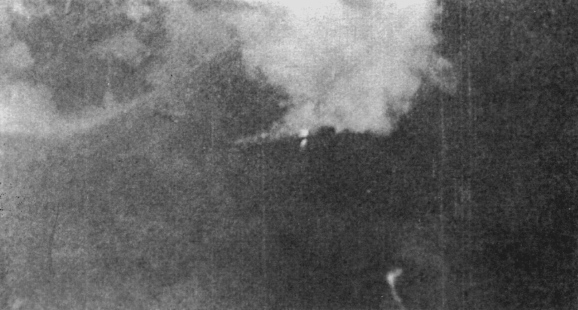 The bright point at the foot of the cloud of smoke is the explosion of a direct hit. This photograph was taken from an altitude of about 2,000 meter (6,600 feet). |
With the sinking of the Tirpitz, Hitler lost the last influential ship of his surface battle fleet and this marked the end of Germany's naval war in northern waters. |
 [ Photos courtesy John Asmussen http://www.bismarck-class.dk ] |
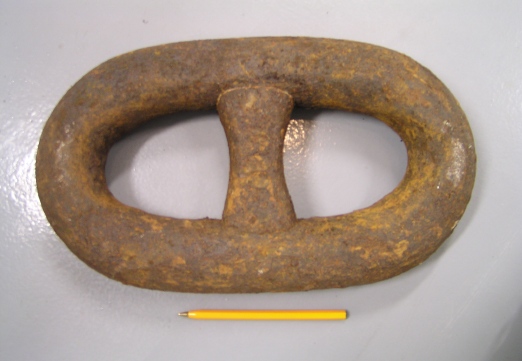 |
|